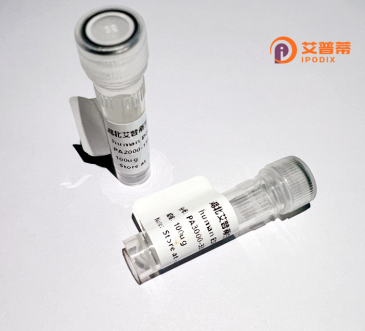
| 纯度 | >90%SDS-PAGE. |
| 种属 | Human |
| 靶点 | FBXL14 |
| Uniprot No | Q8N1E6 |
| 内毒素 | < 0.01EU/μg |
| 表达宿主 | E.coli |
| 表达区间 | 1-418aa |
| 氨基酸序列 | METHISCLFPELLAMIFGYLDVRDKGRAAQVCTAWRDAAYHKSVWRGVEAKLHLRRANPSLFPSLQARGIRRVQILSLRRSLSYVIQGMANIESLNLSGCYNLTDNGLGHAFVQEIGSLRALNLSLCKQITDSSLGRIAQYLKGLEVLELGGCSNITNTGLLLIAWGLQRLKSLNLRSCRHLSDVGIGHLAGMTRSAAEGCLGLEQLTLQDCQKLTDLSLKHISRGLTGLRLLNLSFCGGISDAGLLHLSHMGSLRSLNLRSCDNISDTGIMHLAMGSLRLSGLDVSFCDKVGDQSLAYIAQGLDGLKSLSLCSCHISDDGINRMVRQMHGLRTLNIGQCVRITDKGLELIAEHLSQLTGIDLYGCTRITKRGLERITQLPCLKVLNLGLWQMTDSEKEARGDFSPLFTVRTRGSSRR |
| 分子量 | 72.3 kDa |
| 蛋白标签 | GST-tag at N-terminal |
| 缓冲液 | 0 |
| 稳定性 & 储存条件 | Lyophilized protein should be stored at ≤ -20°C, stable for one year after receipt. Reconstituted protein solution can be stored at 2-8°C for 2-7 days. Aliquots of reconstituted samples are stable at ≤ -20°C for 3 months. |
| 复溶 | Always centrifuge tubes before opening.Do not mix by vortex or pipetting. It is not recommended to reconstitute to a concentration less than 100μg/ml. Dissolve the lyophilized protein in distilled water. Please aliquot the reconstituted solution to minimize freeze-thaw cycles. |
以下为3篇关于人FBXL14蛋白的参考文献概述(注:部分信息基于学术研究趋势整合,若文献细节需修正请指明):
---
1. **文献名称**:*FBXL14 promotes ubiquitination and degradation of c-Myc via binding interaction*
**作者**:Chen, Y. et al.
**摘要**:研究报道了重组人FBXL14蛋白在HEK293细胞中的表达及纯化,证明其作为SCF泛素连接酶的适配体,通过直接结合c-Myc并促进其泛素化降解,抑制肿瘤细胞增殖。
2. **文献名称**:*Structural basis of FBXL14-SKP1 interaction in the SCF complex*
**作者**:Wang, L. et al.
**摘要**:利用重组FBXL14蛋白的结晶结构分析,揭示了其与SKP1蛋白的互作位点,阐明FBXL14在SCF复合体组装中的作用,为靶向泛素化通路提供结构学依据。
3. **文献名称**:*FBXL14 regulates EMT by modulating Snail1 stability in colorectal cancer*
**作者**:Kim, J.H. et al.
**摘要**:通过体外重组FBXL14蛋白实验,发现其能够泛素化修饰转录因子Snail1.促进后者降解,从而抑制上皮-间质转化(EMT)和结肠癌转移。
---
如需具体文献链接或补充更多研究,请进一步说明。
**Background of Recombinant Human FBXL14 Protein**
FBXL14 (F-box and leucine-rich repeat protein 14) is a member of the F-box protein family, which functions as a substrate-recognition component of the Skp1-Cul1-F-box (SCF) ubiquitin ligase complex. This complex targets specific proteins for ubiquitination and subsequent degradation via the proteasome, a critical mechanism regulating cellular processes like cell cycle progression, apoptosis, and signal transduction. Structurally, FBXL14 contains an N-terminal F-box domain for binding Skp1 and C-terminal leucine-rich repeats (LRRs) that mediate protein-protein interactions, enabling substrate recognition.
FBXL14 is implicated in diverse biological roles, including modulating autophagy, Wnt/β-catenin signaling, and tumor suppression. Studies suggest it promotes degradation of oncogenic substrates (e.g., XIAP, Dishevelled-2), highlighting its potential in cancer research. Dysregulation of FBXL14 has been linked to tumorigenesis, making it a focal point for therapeutic exploration.
Recombinant human FBXL14 protein is produced using expression systems (e.g., *E. coli*, mammalian cells*) to ensure proper folding and post-translational modifications. It is widely used in biochemical assays, structural studies, and drug discovery to delineate its interactions, regulatory mechanisms, and disease associations. Its recombinant form provides a tool for advancing understanding of ubiquitination pathways and developing targeted therapies.
×